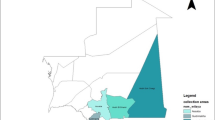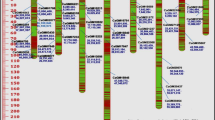Abstract
In order to study the genetic diversity and population structure of broomcorn, a special type of sorghum for broom making, a total of 140 accessions of sorghum varieties including broomcorn (72), half-broomcorn (4), non-broomcorn (64) accessions were genotyped by using 45 simple sequence repeat (SSR) markers that are evenly distributed throughout the sorghum genome. These genotyping analyses demonstrated that the average values of NA (number of alleles per locus), PIC (polymorphism information content) and He (genetic diversity/expected heterozygosity) of the broomcorn accessions were 9.09, 0.60 and 0.63, respectively, which were higher than that of the half-broomcorn accessions (NA, 2.64; PIC, 0.46; He, 0.52) but lower than that of the non-broomcorn accessions (NA, 11.69; PIC, 0.73; He, 0.75). These results implied that the genetic diversity of broomcorn is not as abundant as that of non-broomcorn, and the genetic diversity level of broomcorn is relatively rich. Moreover, the STRUCTURE analysis, phylogenetic analysis and principle coordinate analysis (PCoA) indicated that most of broomcorn collections from Ethiopia (Africa) and Turkey (West Asia) were clustered into one group whereas a majority of broomcorn accessions from East Asia (China, South Korea) were grouped into another group. Two broomcorn individuals from Africa (Sudan) belonged to another distinctive group. These results suggest that broomcorn possesses a wide genetic background and can be divided into three types of differentiation. The information of this study is useful for the understanding of domesticating history and broomcorn differentiations.





Similar content being viewed by others
References
Berenji J, Sikora V (2002) Trends and achievements in broomcorn breeding. Cereal Res Commun 30:81–88
Berenji J, Dahlberg J, Sikora V, Latkovi D (2011) Origin, history, morphology, production, improvement, and utilization of broomcorn [Sorghum bicolor, (L) Moench] in Serbia. Econ Bot 65(2):190–208
Billot C, Ramu P, Bouchet S, Chantereau J, Deu M, Gardes L et al (2013) Massive sorghum collection genotyped with SSR markers to enhance use of global genetic resources. PLoS One 8:e59714
Burow G, Franks CD, Xin Z, Burke JJ (2012) Genetic diversity in a collection of chinese sorghum landraces assessed by microsatellites. Ame J Plant Sci 3:1722–1729
Cai HW, Yuyama N, Tamaki H, Yoshizawa A (2003) Isolation and characterization of simple sequence repeat markers in the hexaploid forage grass timothy (Phleum pratense L.). Theor Appl Genet 107:1337–1349
Caniato FF, Guimarães CT, Schaffert RE, Alves VM, Kochian LV, Borém A, Klein PE, Magalhaes JV (2007) Genetic diversity for aluminum tolerance in sorghum. Theor Appl Genet 114:863–876
Casa AM, Mitchell SE, Hamblin MT, Sun H, Bowers JE, Paterson AH, Aquadro CF, Kresovich S (2005) Diversity and selection in sorghum: simultaneous analyses using simple sequence repeats. Theor Appl Genet 111:23–30
Casa AM, Pressoir G, Brown PJ, Mitchell SE, Rooney WL, Tuinstra MR (2008) Community resources and strategies for association mapping in sorghum. Crop Sci 48:30–40
Doggett H (1988) Sorghum, 2nd edn. John Wiley & Sons, Inc, New York
Earl DA, Vonholdt BM (2012) Structure harvester: a website and program for visualizing structure output and implementing the evanno method. Conserv Genet Resour 4:359–361
Evanno G, Regnaut S, Goudet J (2005) Detecting the number of clusters of individuals using the software STRUCTURE: a simulation study. Mol Ecol 14:2611–2620
Harlan JR, De Wet J (1972) A simplified classification of cultivated sorghum. Crop Sci 12(2):172–176
Liu K, Muse SV (2005) PowerMarker: an integrated analysis environment for genetic marker analysis. Bioinformatics. 21(9):2128–2129
Mace ES, Tai S, Gilding EK, Li Y, Prentis PJ, Bian L et al (2013) Whole-genome sequencing reveals untapped genetic potential in Africa's indigenous cereal crop sorghum. Nat Commun 4(2320):2320
Menz MA, Klein RR, Unruh NC, Rooney WL, Klein PE, Mullet JE (2004) Genetic diversity of public inbreeds of sorghum determined by mapped AFLP and SSR markers. Crop Sci 44:1236–1244
Morris GP, Ramu P, Deshpande SP, Hash CT, Shah T, Upadhyaya HD et al (2013) Population genomic and genome-wide association studies of agroclimatic traits in sorghum. P Natl Acad Sci USA 110(2):453–458
Murray MG, Thompson WF (1980) Rapid isolation of high molecular weight plant DNA. Nucleic Acids Res 8:4321–4325
Nei M, Takezaki N (1983) Estimation of genetic distances and phylogenetic trees from DNA analysis. Proc. 5th world Cong. Genet. Appl. Livestock Prod 21:405–412
Paterson AH et al (2009) The Sorghum bicolor genome and the diversification of grasses. Nature. 457:551–556
Peakall R, Smouse PE (2012) Genalex 6.5: genetic analysis in excel, population genetic software for teaching and research—an update. Bioinformatics. 28:2537–2539
Pritchard JK, Stephens M, Donnelly P (2000) Inference of population structure using multilocus genotype data. Genetics. 155:945–959
Sikora V, Berenji J (2008) Core collection of broomcorn (Sorghum bicolor [L.] Moench). Institute of Field and Vegetable Crops, Novi Sad
Snowden JD (1936) The cultivated races of sorghum. Adlard & Son, Ltd., London
Wang ML, Dean R, Erpelding J, Pederson G (2006) Molecular genetic evaluation of sorghum germplasm differing in response to fungal diseases: rust (Puccinia purpurea) and anthracnose (Collectotrichum graminicola). Euphytica. 148:319–330
Wendorf F, Close AE, Schild R, Wasylikowa K, Housley RA, Harlan JR, Króliket H (1992) Saharan exploitation of plants 8,000 years BP. Nature. 359:721–724
Wright S (1978) Evolution and the genetics of populations. University of Chicago Press, Chicago
Zhan QW, Zhang TZ, Wang BH, Li JQ (2008) Diversity comparison and phylogenetic relationships of S. bicolor and S. sudanense as revealed by SSR markers. Plant Sci 174:9–16
Acknowledgments
This research was supported by The National Key R&D Program of China (2018YFD1000706/2018YFD1000700). We thank the U.S. National Plant Germplasm System (https://npgsweb.ars-grin.gov/) for the provision of part of broomcorn materials in this study.
Author information
Authors and Affiliations
Corresponding author
Additional information
Communicated by: Ray Ming
Publisher’s Note
Springer Nature remains neutral with regard to jurisdictional claims in published maps and institutional affiliations.
Electronic supplementary material
Figure S1
The number of K groups that best fit the dataset (containing 140 individuals genotyped for 45 polymorphic microsatellite loci) detected by the Evanno method. (PNG 88 kb)
Figure S2
Population structures of the 140 sorghum accessions based on the 45 nuclear SSR markers (K = 3). (PNG 500 kb)
Figure S3
The panicle morphology of broomcorn, half-broomcorn and non-broomcorn. SHANGZHUANG, PI 19770 and BTx623 were selected as the sample of broomcorn, half-broomcorn and non-broomcorn, respectively. The red asterisk represents the position of panicle rachis node. (PNG 944 kb)
Figure S4
Geographic origins for 140 sorghum accessions. According to geographical distribution, 24 countries are classified into 6 continents (Africa, America, East Asia, Europe, South and Southeast Asia, West Asia). Each continent is color-coded by different colors (yellow, light rose, bright blue, purple, orange, grass green), respectively. The horizontal axis and the vertical axis represent longitude and latitude, respectively. The circle sizes represent the sample sizes. (PNG 500 kb)
Table S1
Genetic diversity and sequence information of the 45 SSR markers. (XLSX 17 kb)
Table S2
The 140 sorghum accessions used in the study with the information of panicle types, geographic regions and sources. (XLSX 21 kb)
Rights and permissions
About this article
Cite this article
Zhu, M., Chen, J., Yuyama, N. et al. Genetic Diversity and Population Structure of Broomcorn Sorghum Investigated with Simple Sequence Repeat Markers. Tropical Plant Biol. 13, 62–72 (2020). https://doi.org/10.1007/s12042-019-09251-1
Received:
Accepted:
Published:
Issue Date:
DOI: https://doi.org/10.1007/s12042-019-09251-1




